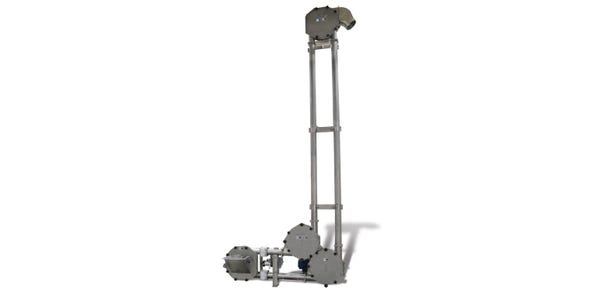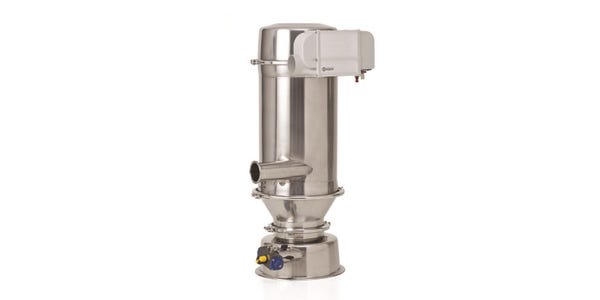Selecting the ideal conveyor can become a daunting task for the buyer who may not be aware of the advantages of the individual types.
February 14, 2020

Don Mackrill, chief operating officer, Spiroflow Systems Inc.
Selecting the ideal conveyor can become a daunting task for the buyer who may not be aware of the advantages of the individual types. A product feasibility test is always advisable to determine the most suitable conveyor for the material concerned, the distance involved, and the throughput required. However, the following guidelines can be used as a starting point.
Flexible Screw Conveyor
The simplest and low-cost solution is the flexible screw type, comprising a stainless-steel spiral rotating within an UHMWPE food-grade tube. This type of conveyor suits materials with a bulk density up to 2.5 kg/l and can carry material to a maximum distance of 20m, although multiple units can extend to greater distances as required. Maximum throughput rate is 20,000 kg/hr.
The term 'flexible' means that the tube and the spiral within it can be curved to some extent. This creates installation flexibility to convey around any obstacles between the inlet and outlet.
The spiral itself has a round cross section in most applications, but a flat version can be used for cohesive or fine materials. It is desirable to have a generous head of material in the feed hopper, as this assists the elevation of material when starting. Also, the conveyor is designed to run full of material; empty running will lead to excessive noise and wear.
Flexible Screw Conveyors in Action
Flexible screw conveyors are used at Farley Health Products in Cumbria. The plant is maintained at full pharmaceutical levels demanding stringent operating standards. An intermediate bulk container (IBC) containing blended product is placed above a sealed hopper. Once in place, the valve of the IBC is opened allowing the product to flow into the hopper without any risk of atmospheric contamination or escape of dust.
The conveyor then carries the product at a very steep angle to a packing system. The system fulfils the very highest levels of hygiene and dust containment, despite strict operating parameters.
The main advantage of the flexible screw type is its simplicity. This results in short installation times and low maintenance. USDA 3A-accepted designs for pharmaceutical use are available, and the whole system can be stripped down for cleaning in minutes. Wear is a problem only with abrasive products, and life with other materials is almost indefinite. Tubes and spirals can be easily replaced.
Aero-Mechanical Conveyor
The aero-mechanical conveyor has the alternative and more descriptive name of a rope and disk conveyor. The rope is actually a continuous loop of steel cable with a series of equally spaced disks secured to it. It travels through a tube around a drive sprocket and a number of idler wheels. This type of conveyor is capable of conveying material vertically up to 20-25m. A major advantage of this type of conveyor is that degradation of the product is almost negligible. This is because the material is carried along in moving pockets of air which are created between successive pairs of disks, similar to the effect of a vacuum or pneumatic system but at significantly lower speeds. Another advantage is that the aero-mechanical conveyor does not need a cyclone or filter to separate the product from the air.

Furthermore, the air carrying the material is not expelled at the outlet. The material is separated from the air that carries it, and the unloaded air current is directed down the return section of the tube. It is therefore retained in the tube circuit. Typical maximum rates of throughput are oats 40 tn/hr; milk powder (26% fat) 20 tn/hr; and granulated sugar 80 tn/hr. If installed vertically, the throughput of the aero-mechanical is unaffected, and material can be lifted at the above-stated rates of throughput to 20 or 25m.
Throughput of the flexible screw conveyor, on the other hand, will diminish the steeper the angle at which it operates. The extent of this depends on the nature of the material. The problem is caused by fallback of material back through the center of the spiral, which can be checked by the provision of a central core or tube. Single flexible screw conveyors of 6 to 8m in length can then be used in the vertical.
An aero-mechanical conveyor should always be started empty and stream fed. In some cases, a controlled feed device, such as a screw or flexible screw conveyor, will have to be used. Maintenance needs are moderate to high. The rope must be tensioned occasionally. Rope life depends on conveyor length, the number of starts and stops, solids loading, and whether routine inspection and tensioning are properly performed.
Vacuuming Conveyor
A pneumatic conveyor uses air to convey materials through an enclosed pipeline. It provides a solution for any user requiring a system that is easy to route, has few moving parts, is dust-tight in operation, and completely empties the system of product with minimum residue. Most systems are derivatives of three basic technologies employing some common equipment in terms of filtration, pipeline fittings, blowers, or compressors.
Vacuum conveying is made under negative pressure, but its use is usually restricted to throughputs of around 10 tn/hr over 50m. The motive air force is provided by either a roots pump or side-channel high-efficiency fan sited at the receiving end of the system. Air-powered venturi systems are also used for low-capacity conveying. However, despite their comparative low capital cost, they can prove more expensive to run.

Vacuum systems are regularly used to transfer material from bag dump units, open containers, drums, silos, and big bag dischargers where longer transfer distances and excellent route flexibility is required. Variants of all the above types of conveyor can be produced in mobile forms for processors who require transfer of materials at several locations.
Wherever materials need to be transferred, vacuum conveying offers distinct advantages in terms of good product flow rates and low maintenance costs.
The main advantage for this type of conveyor is the fact that the product will only come into contact with air throughout the conveying line. Coupled with their dust-free operation and easy-to-clean features, this makes them particularly suitable for transferring food and pharmaceutical materials where the most rigid standards in hygiene and containment need to be met and maintained. The product range for these materials is virtually unlimited and is used for salt, sugar, flour, starch, spices, yeast granules, glucose, talc, and paracetamol. Other industries include the chemical, plastics, water, and minerals.
Don Mackrill is chief operating officer, Spiroflow Systems Inc. For more information on Spiroflow Systems Inc., call 704-291-9595 or visit www.spiroflowsystems.com.
Click here for more articles on mechanical conveying equipment
Click her for more articles on pneumatic conveying equipment
You May Also Like


